The 2020 election wasn't 'stolen.' Here are all the facts that prove it.
The United States has been conducting presidential elections for 232 years. No modern candidate has ever refused to accept the results and recognize the winner’s legitimacy.
In this sense, 2020 has been different than any contest since the Civil War, as President Trump continues to claim that President-elect Joe Biden “stole” the election from him — even though 538 certified electors will convene Monday at statehouses across the country and deliver 306 electoral votes to Biden.
When that happens, the 2020 election, conducted in the midst of a pandemic, with by far the most votes ever cast, will be over. And despite Trump’s refusal to concede, there is every indication that it was run honestly and the results tabulated accurately — a tribute to the professionalism and integrity of officials across the country.
Before Election Day, the Trump administration invited a delegation of 28 international experts from the Organization of American States, which has reported on elections around the world, to observe the vote. Its preliminary report found zero evidence of significant fraud.
Last month, the New York Times spoke to top election officials in 49 of 50 states. Not one, Democrat or Republican, reported “that fraud or other irregularities played a role in the outcome of the presidential race.”
On Nov. 12, the coordinating council overseeing the voting systems used around the country said in an unprecedented statement distributed by Trump’s own Cybersecurity and Infrastructure Security Agency (CISA) that “the November 3rd election was the most secure in American history” and that “there is no evidence that any voting system deleted or lost votes, changed votes, or was in any way compromised.”
And all but one of the 60 post-election lawsuits filed by Trump and his allies to challenge the results has failed in the courts or been withdrawn. Dozens of those cases were dismissed by conservative judges appointed by Trump or other Republicans.
Unwilling to disenfranchise millions of voters and reverse the results of the presidential election, the U.S. Supreme Court refused on Friday to hear a flimsy lawsuit that Texas sought to file against Pennsylvania, Wisconsin, Michigan and Georgia, effectively exhausting Trump’s legal options.
Yet the avalanche of misinformation will continue long after Trump has left office.
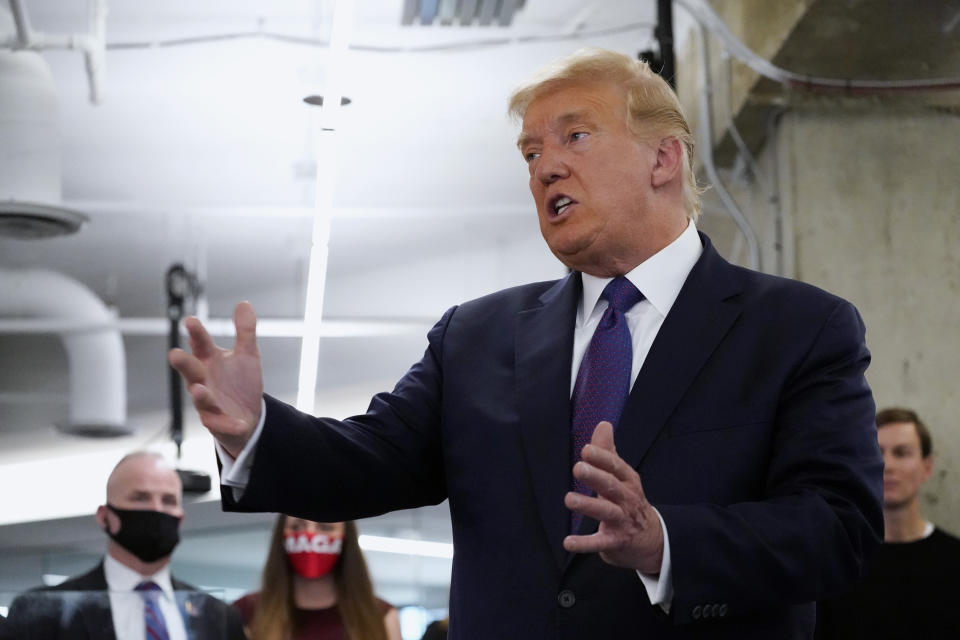
Online, the ominous-but-ultimately-overblown stories will keep circulating — stories of pollsters falsifying their surveys to hurt Trump, of dead people voting, of observers being blocked from watching the count, of mysterious batches of Biden votes suddenly materializing in Democratic cities, of computer glitches changing the results, and so on.
As a result, Trump’s loyal supporters will keep believing that maybe something happened in 2020 that’s never happened before. They will believe the election was stolen.
It wasn’t. Nationally, Biden won by more than 7 million votes. And time after time, when given the chance to offer actual evidence of fraud, Trump lawyers and their allies declined to do so, instead arguing that they didn’t like the way some states changed their rules to make voting easier during a pandemic.
These lawyers asked the courts to throw out millions of legal votes based only on this, and the courts rejected them every time they did so. In Wisconsin on Saturday, U.S. District Judge Brett H. Ludwig — who Trump appointed to the bench — said the president’s attorneys had failed to win their case “as a matter of law and fact.”
“This is an extraordinary case,” Ludwig wrote at the beginning of his decision. “A sitting president who did not prevail in his bid for re-election has asked for federal court help in setting aside the popular vote based on disputed election administration issues he plainly could have raised before the vote occurred.”
To be sure, some small amount of real fraud happens in every election, and 2020 is likely no exception. But history shows that such incidents are few, far between and ultimately inconsequential — nowhere near the scale of tens or hundreds of thousands of votes needed to affect the outcome in key states.
In 2014, Loyola Law School professor and voting expert Justin Levitt investigated every general, primary, special and municipal election held since the year 2000. Of more than 1 billion ballots cast, he found just 31 credible instances of potential voter impersonation, which is one of a few ways that cheating can actually occur.
So here are the facts, and just the facts, on some of the major “fraud” rumors flooding your inbox and your newsfeed.
Rumor: Hundreds of statistical irregularities and witness accounts of fraud have surfaced since the election, raising new questions about the integrity of the results
Reality: These are old allegations that have already been debunked and dismissed in court
In the first week or so after the election, the outgoing president offered a number of reasons why his claim to have been cheated out of a second term might be true, all of which were easily and quickly debunked.
But over the past month, the strategy by Trump and those who still believe his insistence that the election was rigged seems to have shifted slightly, or evolved.
They have combined a series of so-called analyses from pseudo-experts with an effort to flood the internet with countless examples of supposed evidence.
Facts “don’t even matter anymore” to Trump’s effort, Rick Hasen, an election expert who is author of “Election Meltdown,” told Yahoo News.
The Trump effort has apparently become to create the impression that “so many cases must signal something,” Hasen said.
Hasen said that the Trump strategy has clearly become “all about flooding the zone with s***,” as former Trump adviser Steve Bannon once described his political strategy to overwhelm political opponents by swamping them with so much information it’s impossible to sort through it all.
Trump’s own 46-minute video he released on December 3, which PolitiFact debunked point by point, was a good example.
And there are echoes here of disinformation efforts in other countries. Peter Pomerantsev, a senior fellow at the SNF Agora Institute at Johns Hopkins University, said that, in Russia, claims by the government “are just thrown online or spewed out on TV shows more to confuse than to convince."
Pomerantsev’s book, “This is Not Propaganda: Adventures in the War Against Reality,” details how in Russia, “all information becomes … merely a means to undermine an enemy, as a tool to disrupt, delay, confuse, subvert.”
Overwhelming one’s opponents with an onslaught of allegations has a single goal, he wrote. "The effect ... is to leave the mind exhausted and confused,” he wrote.
Yet even a perfunctory review of most examples offered up by Trump and his allies as “evidence” quickly reveals that most have already been debunked and dismissed in court.
One popular claim among conspiracy theorists was that election officials in Fulton County, Georgia told independent monitors to leave the vote-counting room and then brought illegal ballots in suitcases out from under a table.
This claim was based on a lack of understanding of how the process worked. State officials running the election, who are Republicans, explained how there was one group of workers opening mail ballot envelopes and verifying they had been properly cast, and another taking the ballots out of the proper bins and running them through counting machines.
The first group of workers left, as did some monitors, but officials from the Secretary of State’s office observed the entire time and no one was ever told to leave. There were no suitcases.
As quickly as one allegation is checked, however, 10 more pop up in its place. Most times they are not new, but rather they are allegations that have already been debunked and dismissed in court, but they are presented as somehow new.
For example, the website hereistheevidence.com purports to have an incredible amount of proof of election fraud, with over 1,300 entries, all of them with a listed “source.”
But the site is not a serious compendium of legitimate evidence of anything. It is a hopelessly redundant, badly organized, terribly sourced jumble. Take the first 10 examples of so-called “illegal votes.”
The first is a claim that in Georgia there were more than 143,000 votes that violated state law. This is part of a lawsuit filed Dec. 4 by Trump himself in the Superior Court of Fulton County. Democrats have filed a response to this noting the “widespread acknowledgement that no fraud occurred” in the Georgia election, as attested to by three separate recounts of the vote.
The second claim is that there were more than 42,000 people in Nevada who voted twice. This claim has already been rejected and dismissed by state District Court Judge James Todd Russell, a ruling affirmed unanimously by the Nevada Supreme Court.
The next five claims are all part of a lawsuit already dismissed by U.S. District Judge Timothy Batten. Many of these claims rely on assertions made by Matt Braynard, who led the data effort on Trump’s 2016 campaign until he was let go in April of that year. Braynard worked at the Republican National Committee around 15 years prior to that as a data staffer.
Braynard has presented his assertions in a 42-minute YouTube video. Harvard professor Stephen Ansolabehere studied Braynard’s work and concluded in a 49-page report that "there is no scientific basis for reaching any of these conclusions." In addition, when Braynard testified before a panel of Georgia lawmakers, state Rep. Bee Nguyen, a Democrat from Atlanta, went through a list of individuals who Braynard had claimed voted illegally and debunked them in real time, showing how these people had, in fact, voted legally.
And the next three claims after that on hereistheevidence.com follow the same pattern. They are all allegations that were included in the lawsuit in Nevada referenced above — the one that claimed 42,000 double votes — that was dismissed by Judge Russell and the Nevada Supreme Court.
By contrast, the list of cases compiled by Democratic lawyer Marc Elias at DemocracyDocket.com presents all of the litigation in each state with links to every court filing and judicial ruling in all 60 cases.
While keeping track of all these court cases and the many filings in each is overwhelming, there is a logic to it that can be followed. It is orderly and comprehensible.
The claims made by Trump and his supporters are so disorganized and non-linear that they border on incoherence. But that seems to be the point.
RUMOR: Democrats and Dominion Voting Systems tampered with computers to change the results
REALITY: Officials quickly fixed isolated glitches and accidents, only two of which involved Dominion and none of which affected the final vote count

No election goes off without a hitch, and in the internet era, technology can compound some of the usual mistakes. But there’s a big difference between Democrats conspiring with Dominion Voting Systems to “hack” election and delete Republican votes and the kind of minor, easily detectable and correctible data-entry accidents and software glitches that complicate any computer-based enterprise.
The first is what Trump & Co. darkly speculate, without evidence, to have taken place in close-run states.
The second is what actually happened.
Consider the example of Antrim County, Mich., a Republican stronghold where unofficial results initially showed Biden beating Trump by roughly 3,000 votes — a sharp reversal from Trump's performance there in 2016. Trump supporters flagged the discrepancy. Tweets about it went viral. Soon conservatives such as Ted Cruz were calling for investigations and alleging that maybe the same election-management software used in Antrim County (Dominion Voting Systems) had screwed up the statewide count.
Experts eventually figured out what went wrong: An election worker had “configured ballot scanners and reporting systems with slightly different versions of the ballot, which meant some results did not line up with the right candidate when officials loaded them into the system,” according to the New York Times. By then local officials had already caught and corrected the error — even before another round of review conducted by Republican and Democratic “canvassers” that is designed to catch such mistakes. In the revised count, Trump beat Biden by roughly 2,500 votes.
But these facts haven’t deterred Trump allies from seizing on other, unrelated examples of routine tech-related errors to falsely insinuate some sort of nefarious conspiracy involving Dominion. In Oakland County, Mich., election workers mistakenly counted votes from the city of Rochester Hills twice, according to the Michigan Department of State — then spotted and fixed their error. An incumbent Republican county commissioner kept his seat as a result.
“As a Republican, I am disturbed that this is intentionally being mischaracterized to undermine the election process,” Tina Barton, the clerk in Rochester Hills, said in a video she posted online. “This was an isolated mistake that was quickly rectified.”
Oakland County used software from a company called Hart InterCivic, not Dominion.
Meanwhile in Georgia, glitchy software updates affected how poll workers checked in voters in Spalding and Morgan counties, which both halted voting for a few hours. In another Georgia county, Gwinnett, a different glitch delayed the reporting of results.
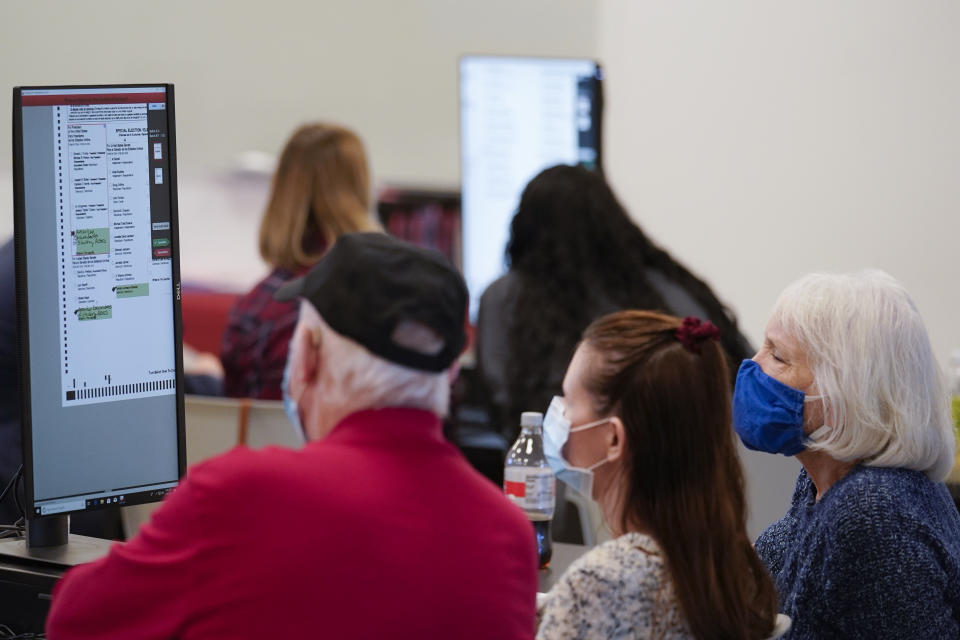
Gwinnett County used Dominion; the other counties did not. In any case, the issues did not affect the counts. Trump won Spalding County by 21 points and Morgan County by 42; Biden won Gwinnett by 18.
Elsewhere, fringier far-right activists have vaguely theorized that secret CIA computer systems called “Hammer” and “Scorecard” hacked the election on Biden’s behalf, pointing to momentary inconsistencies in CNN’s unofficial, on-air vote tallies for the 2019 Kentucky gubernatorial race as evidence. There is no proof that Hammer and Scorecard exist, and even if they did, experts say they would not be able to intercept the digital transmission of vote results and change them without being detected; officials always compare the transmitted results to paper receipts from the original machines before certifying the outcome.
“The Hammer and Scorecard nonsense [is] just that — nonsense,” tweeted Cybersecurity and Infrastructure Security Agency director Chris Krebs. “This is not a real thing, don’t fall for it and think 2x before you share.”
Yet Twitter and Facebook posts from Trump and White House press secretary Kayleigh McEnany falsely implied that the isolated issues in Michigan and Georgia were signs of widespread problems with the election. On Thursday, the president even went so far as to tweet that Dominion itself had deleted millions of his votes — a claim with no basis in reality. He followed up Sunday and Monday by echoing baseless conspiracy theories alleging Democratic control of Dominion, which have been debunked as well. The president has not provided a shred of proof that software switched or deleted a single one of his votes — let alone the tens or even hundreds of thousands he would need to overturn his losses in Michigan, Georgia and elsewhere.
Not to be deterred, however, Georgia’s two Republican senators, who are jockeying for advantage in their Jan. 5 runoff elections, called on Brad Raffensperger, the state’s Republican secretary of state, to resign because he had “failed the people of Georgia.”
“That is not going to happen,” Raffensperger said in a statement. “My job is to follow Georgia law and see to it that all legal votes, and no illegal votes, are counted properly and accurately. … As a Republican, I am concerned about Republicans keeping the U.S. Senate. I recommend that Senators Loeffler and Perdue start focusing on that.”

RUMOR: Biden won only because of ‘illegal’ votes
REALITY: Actual illegal votes are rare, and the courts are considering all credible charges
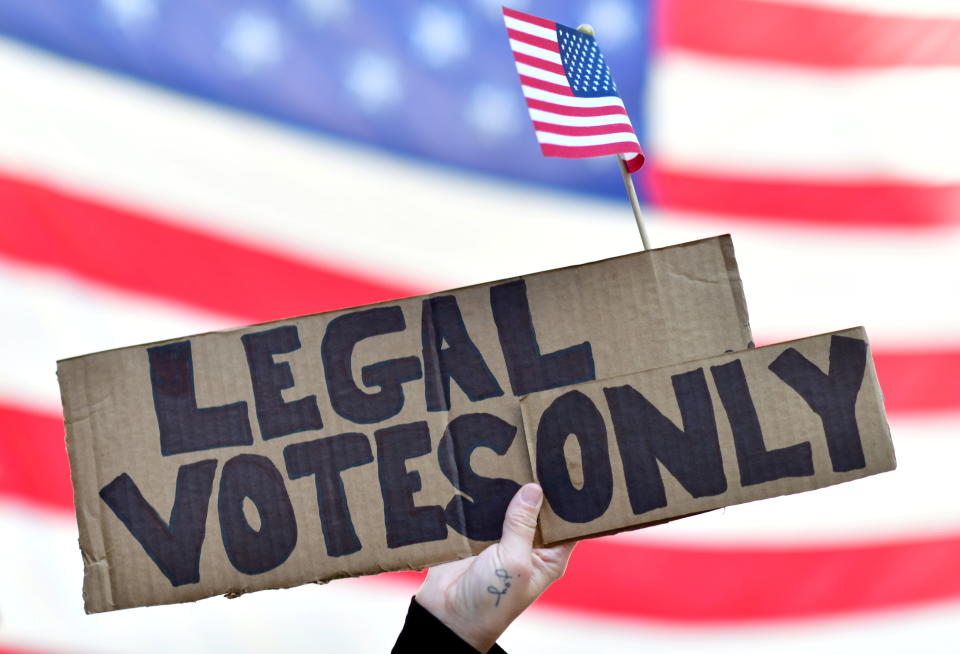
In every election, some people cast ballots that end up not counting because they run afoul of state election law for one reason or another. It’s critical to the integrity of the election — and public trust in America’s democratic process — that officials identify and disqualify such votes. Every state has numerous safeguards in place to ensure that’s exactly what happens.
But the mere existence of irregularities doesn’t invalidate an election. If it did, no election would be valid. Scale is important here, too. Illegal votes can affect the outcome only if enough of them benefit the winner to potentially account for his or her entire margin of victory.
“One would have to show, at minimum, more illegal votes than the margin between the candidates,” Richard Hasen, a law and political science professor at the University of California, Irvine, and a nationally recognized election law expert, recently explained. “That would be quite an extreme scale of fraud. Let’s see what the evidence is.”
The evidence of illegal votes in the 2020 election has been exceedingly thin.
One of the most detailed complaints about the possibility that ineligible voters cast ballots, or that votes were manufactured, came in a lawsuit filed in Michigan on Nov. 9. A pro-Trump lawsuit against the city of Detroit, filed by the Great Lakes Justice Center, claimed that election workers were told not to check signatures on mail ballots, that extra mail ballots were brought in and all counted for Biden, that election workers backdated mail ballots so they could be counted, and that they “used false information to process ballots.”
The lawsuit also claimed election observers were blocked from watching vote counting at key moments, that votes from ineligible voters were counted and that a handful of city workers “coached” voters to cast ballots for Biden.
But the city filed a detailed response, knocking down the allegations and saying they reflected “an extraordinary failure to understand how elections function.”
Election workers at the TCF Center, a Detroit convention center where much of the county’s vote tabulation took place, were instructed not to check mail-ballot signatures during the count, the city said, because signature matching had already been done before the ballots arrived at the facility.

Complaints made in the Great Lakes lawsuit about mail ballots — known in Michigan as absent voter ballots — being backdated, with the implication that they had arrived after Election Day, were also plainly false, the city said. “No ballots received by the Detroit City Clerk after 8:00 p.m. on November 3, 2020 were even brought to the TCF Center,” the city’s attorneys wrote. “No ballot could have been ‘backdated,’ because no ballot received after 8:00 p.m. on November 3, 2020 was ever at the TCF Center.”
As for the notion that ineligible votes were counted, or that votes were concocted out of thin air and assigned to names of people who didn’t vote, the city said that what Republican observers inside TCF really saw was election workers correcting an error by some election workers at satellite locations, who failed to complete a process that allowed some mail ballots to be counted. It was necessary to enter the date for these ballots to allow them to count, the city said.
“Every single ballot delivered to the TCF Center had already been verified as having been completed by an eligible voter,” the city said.
The charge of extra ballots being brought in was related to the arrival of blank ballots that were sent to TCF for use by election workers. These ballots were given to election workers so they could function as duplicate ballots in case legitimate ballots were damaged and could not be read by voting machines, the filing said.
“Michigan election law does not call for partisan challengers to be present when a ballot is duplicated; instead, when a ballot is duplicated as a result of a ‘false read,’ the duplication is overseen by one Republican and one Democratic inspector coordinating together,” Detroit’s lawyers wrote. “That process was followed, and Plaintiffs do not — and cannot — present any evidence to the contrary.”
The Trump campaign, in a lawsuit of its own filed Tuesday in the U.S. District Court for the Western District of Michigan, claimed there were cases in which “ballot duplication was performed only by Democratic election workers, not bipartisan teams.” This claim has already been dismissed in one lawsuit filed last week by the Trump campaign in Michigan’s Court of Claims.
The accusation of “false information” was based on records that list some voters as having been born in the year 1900. The city said some mail ballots that arrived between Sunday night and Tuesday — all before the close of polls on Tuesday night — needed to have the birth date manually entered due to a software “quirk.”
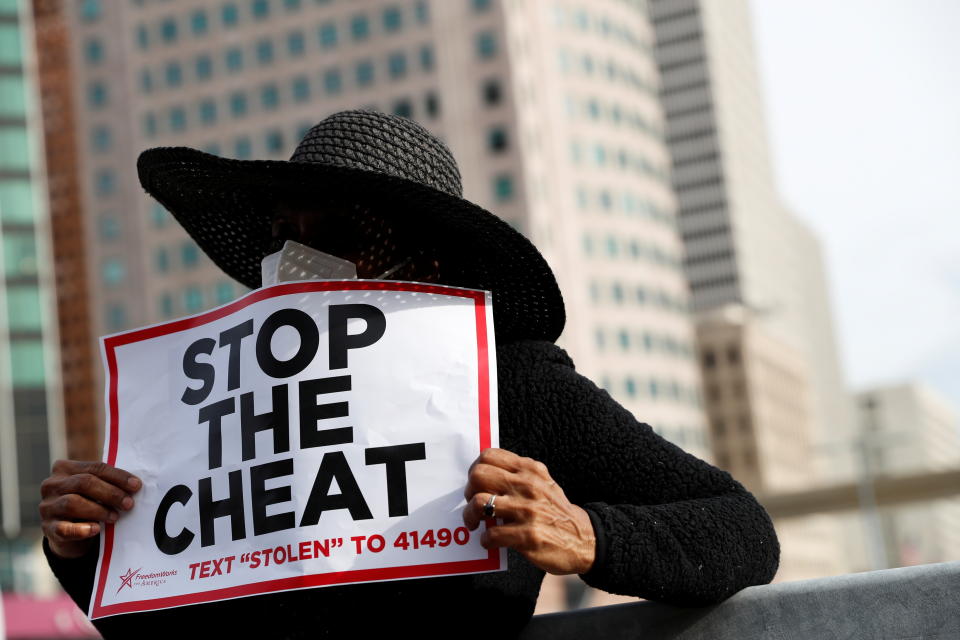
Election workers entering the birth date for those ballots used Jan. 1, 1900, as a “placeholder date” until the ballot entry could be matched to the voter’s entry in the state voter file. “That birthday will appear in several places in the electronic poll book record for a limited period,” the city said.
That leaves the allegation of city workers “coaching” voters to cast ballots for Biden, a claim made by a city worker named Jessy Jacob in the lawsuit.
The city said that if this were true it would be “contrary to the instructions given to workers at the satellite locations,” but also said it was “curious that Ms. Jacob waited until after the election to raise these allegations.”
The city noted that Jacob had been furloughed prior to the election, was brought back to work during election season in September and was furloughed again immediately after the election.
The filing also pointed to evidence on social media that two of the individuals who signed affidavits in the Great Lakes lawsuit were adherents of the pro-Trump QAnon conspiracy theory.
The Detroit lawyers also pointed out that Trump received almost three times as many votes in Detroit in the 2020 election as he did four years ago: 12,654, up from 4,972 in 2016. (The vote for Biden in Detroit this year was just under 234,000, which was about 1,000 votes less than Hillary Clinton’s total in 2016. But Biden won the state by almost 150,000 votes.)
“Nothing about those numbers supports the theory of fraud being advanced. Nothing about those numbers supports the completely unsubstantiated claims of tens of thousands of improperly processed ballots,” the city said.

RUMOR: ‘Dead people’ voted for Biden
REALITY: The Trump campaign hasn’t been able to produce more than one or two potential examples of ‘dead people’ casting ballots (and no one knows who they voted for)

It’s a perennial claim in American politics: The only reason my candidate lost is because a bunch of dead people voted for your candidate. And Trump ally Lindsey Graham, the recently reelected Republican senator from South Carolina, is its latest proponent.
“The Trump team has canvassed all early voters and absentee mail-in ballots in Pennsylvania, and they have found over 100 people they think were dead [and] 15 people that we verified that have been dead who voted,” Graham said during a Fox News interview. “Six people registered after they died and voted. In Pennsylvania, I guess you’re never out of it.”
Graham isn’t alone in accusing the deceased of meddling in the election; members of Trump's family and supporters like former House Speaker Newt Gingrich and former acting Director of National Intelligence Richard Grenell have repeated similar charges. Meanwhile, a series of viral tweets and videos shared by Trump fans have also accused various Michigan residents — some with birth dates from the turn of the 20th century — of casting absentee ballots from beyond the grave.
The implication is that somehow Democrats filled out and fraudulently submitted ballots in the names of dead people in order to lift Biden to victory.
But that just doesn’t compute.
In reality, 13 states actually count absentee ballots submitted by living voters who then die before Election Day, according to the National Conference of State Legislatures. So some of these so-called illegal votes are, in fact, perfectly legal.
Elsewhere, states prohibit counting the votes of people who are no longer alive. They do this in two ways: by disqualifying the early votes or mail ballots of residents who wind up dying before Election Day and/or by promptly flagging voters who have recently died so officials can cross-reference the voter rolls and discount any ballots cast in their name.
It’s a complicated, fast-moving process, and sometimes the human beings in charge of it make mistakes. One viral video, for instance, purports to show that “118-year-old ‘William Bradley’ voted via absentee ballot in Wayne County, Mich.” But what actually happened, according to Politifact, is that Bradley’s son — also named William Bradley and residing at the same address, but not born in March 1902 and definitely not deceased — voted with his own ballot, which officials then incorrectly attributed to his father.
“No ballot was cast for the now deceased Bradley,” Politifact explained. “This was a clerical error, not voter fraud.”
Another Michigan voter, named Donna Brydges, was also cited in viral pro-Trump videos because her birth date was listed as 1901 in the state’s qualified voter database. Turns out that Brydges is 75 and voted legally; her DOB was merely a placeholder.
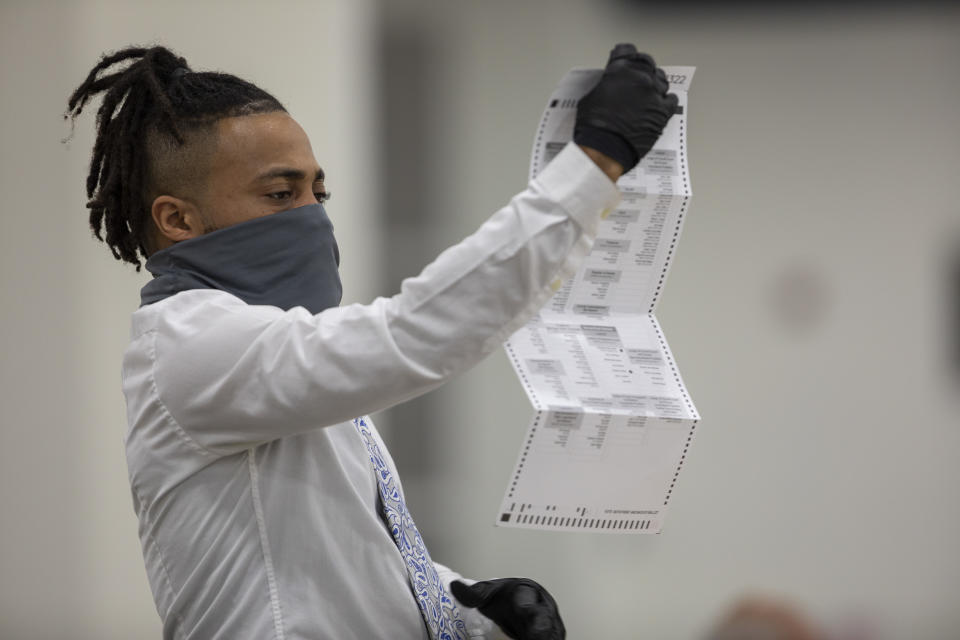
“It is important to note that some state registration systems indicate a missing date of birth by adopting filler dates, such as 01/01/1900, 01/01/1850, or 01/01/1800,” a 2017 report about duplicate voting from the Government Accountability Institute noted. “The vast majority of votes cast by individuals appearing to be over 115 years old had these three erroneous birthdates.”
Likewise, CNN recently checked 50 of the more than 14,000 names on a list of allegedly dead-but-registered Michigan voters making the rounds on Twitter and found that only five of them voted in 2020 — and all five are, in fact, alive.
None of the 37 actually dead people in CNN’s sample cast a ballot.
Whatever the exact figures, we’re talking about a small handful of ballots here — nowhere near the number Trump would need to catch up in Michigan, where he trails by about 147,000 votes, or Pennsylvania, where he trails by 45,000. A suit filed by a conservative foundation in Pennsylvania alleged that the state included 21,000 dead people on its voter rolls. But “the court found no deficiency in how Pennsylvania maintains its voter rolls,” according to a spokeswoman for the state attorney general’s office, and “there is currently no proof provided that any deceased person has voted in the 2020 election.”
And even then there’s no reason to think the dead favor Democrats over Republicans. In October, a man in Luzerne County, Pa. — a registered Republican — was charged with felonies after trying to apply for a mail ballot in his dead mother’s name. On Nov. 7, meanwhile, Trump campaign adviser Corey Lewandowski provided what he said was “one concrete example” of dead-voter fraud, pointing to an obituary for Denise Ondick of West Homestead in Allegheny County, Pa., who died on Oct. 22 — one day before election officials received her application for a mail-in ballot, according to online records from the Pennsylvania Department of State, and 11 days before the county received and recorded her vote. The Trump campaign has cited a single, similar incident in Nevada.
In an interview with the Philadelphia Inquirer, Ondick’s daughter said she helped her mother fill out an application for a mail ballot in early October, before the elder Ondick died of cancer, but that she could not explain why the ballot had been sent in after her mother’s death. Ondick’s husband said he couldn’t recall doing anything with the ballot.
Ondick’s daughter also said her mother had planned to vote for Trump.
Lewandowski said Ondick was “one of many” examples of dead-voter fraud the Trump campaign would be asking the courts to review. So far, the campaign has not revealed any additional details or mentioned any other specific cases.

RUMOR: Democrats blocked Republican observers from watching the count
REALITY: Republican lawyers for the Trump campaign have admitted in court that this is false
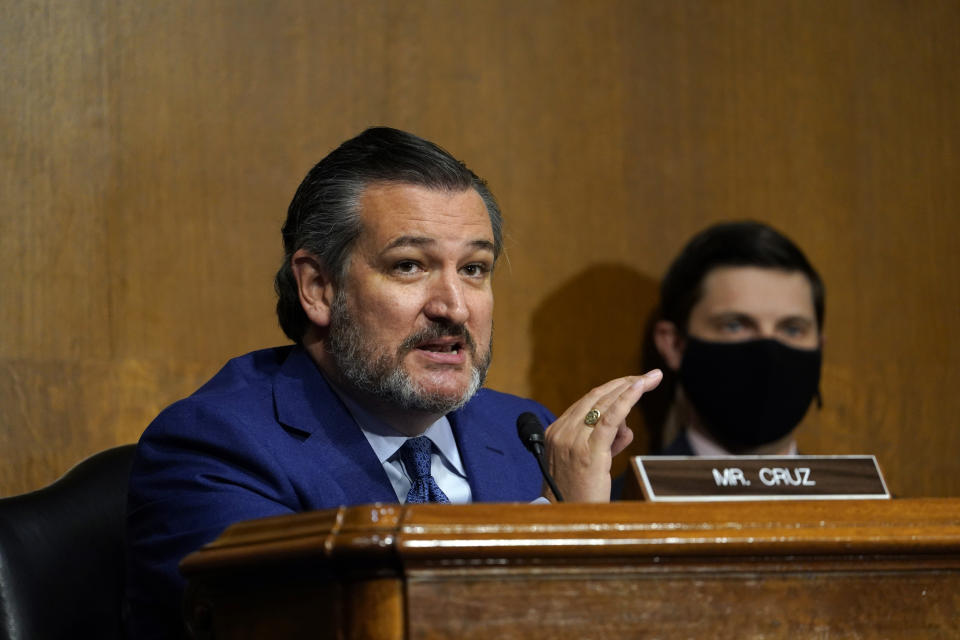
Republicans have focused these complaints on Detroit and Philadelphia.
“We’re seeing this pattern in Democratic city after Democratic city, but the worst of the country right now is Philadelphia, Pennsylvania, were they’re not allowing election observers in, despite clear state law that requires election observers being there, despite an order from a state judge saying election observers have to be within 6 feet of the ballot counting,” Sen. Ted Cruz, R-Texas, said on Nov. 5, on Sean Hannity’s Fox News show.
“I am angry and I think the American people are angry because by throwing the observers out, by clouding the vote counting in a shroud of darkness, they are setting the stage to potentially steal the election,” Cruz said.
These allegations were repeated by Sens. Josh Hawley, R-Mo., and Lindsey Graham, R-S.C.
But the Trump campaign’s own lawyers acknowledged in a hearing that there have been Republican observers in the room at all times since mail ballots began to be opened and counted at the Pennsylvania Convention Center.
“Their counsel admitted at the hearing, after questions from the court, that they had several representatives in the room,” said the Philadelphia City Commissioners in a statement. The commissioners, two Democrats and one Republican who oversee voting in the city, said there were between 15 and 19 Republican observers present all day on Nov. 5.
Hawley also said that “some states [were] going to court to try to stop poll watchers, people just observing the ballot counts.”
“I mean, that is deeply, deeply disturbing,” he said.
That was another false claim. The city of Philadelphia appealed a ruling that partisan observers should be allowed to oversee the work of election officials from as close as 6 feet away. There was never an allegation in the suit that poll watchers were being barred from the room.
The Trump campaign’s lawsuit had alleged that its observers, who were in the room with unobstructed views, wanted to get closer so they could challenge individual mail ballots if there was no signature on the outer envelope, or if the voter had written the wrong date on the envelope.
The city’s appeal argued that state law does not permit those kinds of challenges, a decision the state legislature made in recognition that allowing challenges to individual ballots would slow down the processing of a historic number of mail ballots during the COVID-19 pandemic.
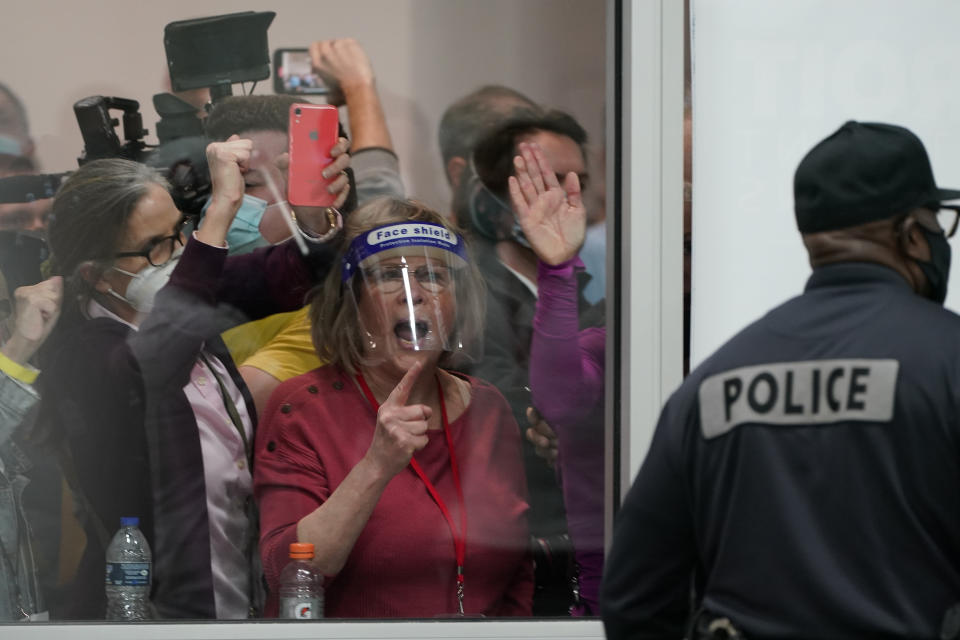
Challenging the eligibility of voters to cast mail ballots had to be done when the ballots were requested, Tammy Bruce, a former Arizona elections official, told Yahoo News.
Observers in the room are entitled to see that mail ballots are being examined for signatures and that they were properly placed inside a privacy envelope, and to monitor for anything else of concern, such as the destruction or discarding of ballots.
Gingrich, also on Fox, claimed poll watchers had been “physically excluded” from overseeing vote counting.
He pointed specifically to Detroit, where there were complaints about election officials covering the windows of a counting room at the TCF Center.
“You have a precinct where you don’t let anyone in. They’re boarded up,” Gingrich claimed. “I would take every precinct that blocked poll watchers and not count their votes.”
But a Detroit city attorney said the windows were blocked because ballots were being counted closely enough to them that members of the public could take photos that might disclose the privacy of voters’ ballots.
There were “hundreds of challengers from both parties … inside the Central Counting Board all afternoon and all evening,” said Detroit attorney Lawrence Garcia.
The city of Detroit noted in a court filing that “more than 200 Republican challengers were present at the TCF center, and at no time were they limited to fewer than one challenger for every Absent Voter Counting Board. While six feet of separation was necessary for health reasons, the Department of Elections provided large computer monitors at every counting board, so that challengers could view all information as it was inputted into the computer.”
“When it became clear that the number of challengers had reached or exceeded the lawful quota and the room had become over-crowded, additional challengers were not admitted until challengers from their respective parties voluntarily departed.”
When Yahoo News asked Gingrich what proof he had of observers being “physically excluded” from vote-counting centers, a Gingrich spokesman essentially admitted there was none. “With regard to the people being kept from watching ballots being counted, we now have a better understanding of the situations in Philadelphia and Detroit,” said Louie Brogdon, editorial director of Gingrich 360, a consulting and media production firm.
“When Speaker Gingrich made his earlier comment, he was speaking on the best information he had at the time,” Brogdon said.

RUMOR: Democrats suddenly ‘found’ new, fraudulent Biden votes to beat Trump
REALITY: Counting mail ballots took a long time in some states, like Pennsylvania, because the Republican Party blocked reforms that would have avoided this problem
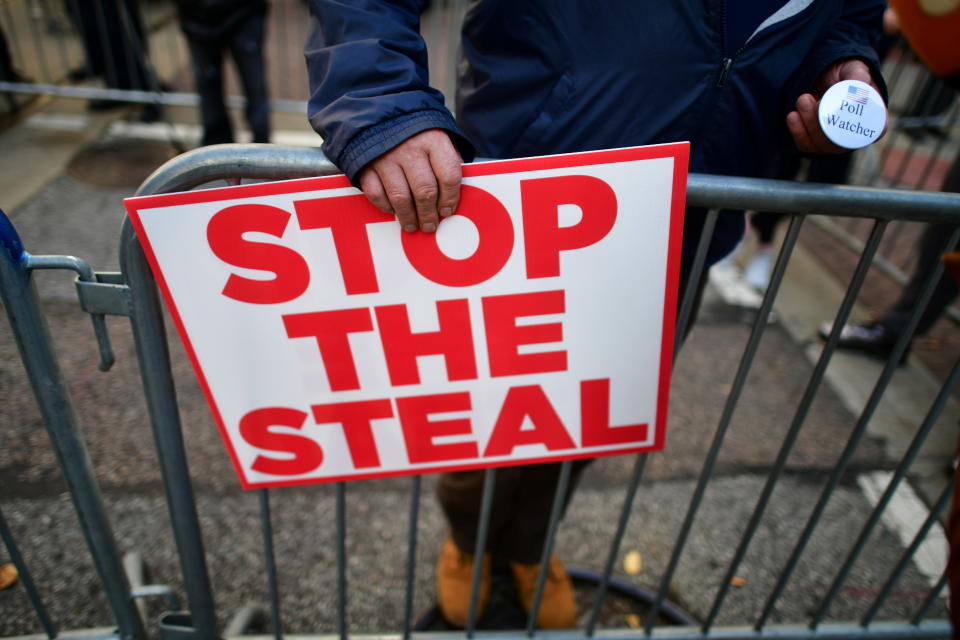
In the days after Election Day, Trump said several times that Democrats were trying to cheat him by “finding” votes for Biden.
“They are finding Biden votes all over the place — in Pennsylvania, Wisconsin, and Michigan. So bad for our Country!” the president tweeted just before noon on Wednesday, Nov. 4.
His mention of those three states is telling. They are the same ones that Yahoo News was writing about for three months leading up to the election, raising awareness about what one Pennsylvania Republican warned in September was a “man-made disaster … that easily could be avoided.”
The disaster happened. It didn’t have to. And it created space for the president to falsely claim that votes were being “found” when in fact they were simply being counted in a delayed fashion. The delay was caused — seemingly intentionally — by the Republican Party itself.
Here’s what happened. After the outbreak of COVID-19 in the late winter and early spring, most states allowed all voters to cast ballots by mail in the spring and early summer, during primary elections. Over the summer, some states moved back to a focus on in-person voting. But most stuck with expanded access to voting by mail.
For many states this was new. But five states have conducted their elections by mail for years now: Colorado, Utah, Washington, Oregon and Hawaii. Two more, Arizona and California, have done their elections mostly by mail for a few years.
As states moved to voting by mail, most had rules that allowed election clerks to process those ballots as they arrived. As Ohio Secretary of State Frank LaRose, a Republican, told Yahoo News in August, “We can start processing those right away, meaning: Cut the envelope, open, verify the information on it, put it through the scanner, but not hit ‘tabulate.’ That can’t happen until 7:30 on election night.”
As a result, Ohio had most of its mail ballots counted early on election night. Most states did.
But Wisconsin, Michigan and Pennsylvania — the same three states mentioned by Trump in his tweet — refused to make a change allowing clerks to process mail ballots like the rest of the country.
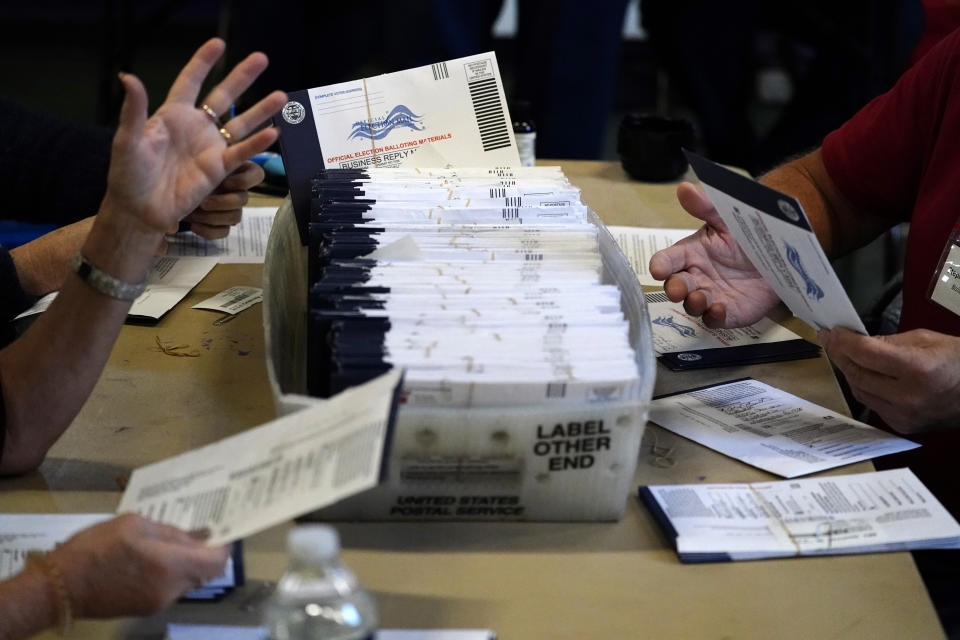
Action was needed from the state legislature, and in all three states the Republican Party held majorities in both the state Senate and the state House.
LaRose himself warned of a “really terrible situation” if these legislatures didn’t make a simple change, giving clerks time to process mail ballots before Election Day.
In other words, the GOP knew its lack of action was going to delay the counting of mail ballots by several days, and either did nothing or — as in the case of Michigan — gave clerks one day ahead of Election Day to process mail ballots, rather than the week or two that experts and election officials recommended.
In Pennsylvania, Republicans at first allowed clerks to start processing mail ballots 21 days before Election Day, but then cut that down to three and included a number of “poison pill” ideas in its bill that guaranteed Democrats would oppose it.
There has been no evidence of ballots being added. That has happened before in Philadelphia, but on a very small scale. In May, an election judge there pleaded guilty to adding a total of 113 votes over three elections from 2014 to 2016 to help judicial candidates running for a local court.
The point made by LaRose and other Republican experts is that even isolated examples of cheating, which do happen, do not add up to a conspiracy. To manipulate tens of thousands of votes without detection is not possible given the multiple layers of security and accountability involved in running elections, experts say.
One of those layers is the postelection audit that each state conducts itself to ensure that the result was accurate.

RUMOR: Pollsters falsified their results to suppress the GOP vote
REALITY: Republicans turned out in record numbers even though pollsters mistakenly underestimated Trump again

Last Thursday, Trump told reporters that pollsters had deliberately produced false surveys showing Biden with a big lead in order to suppress Trump votes and help Biden win the election.
He followed up Monday night with a series of tweets repeating the same claim.
“.@FoxNews, @QuinnipiacPoll, ABC/WaPo, NBC/WSJ were so inaccurate with their polls on me, that it really is tampering with an Election,” Trump wrote. “They were so far off in their polling, and in their attempt to suppress - that they should be called out for Election Interference … ABC/WaPo had me down 17 points in Wisconsin, the day before the election, and I WON! In Iowa, the polls had us 4 points down, and I won by 8.2%! Fox News and Quinnipiac were wrong on everything… The worst polling ever, and then they’ll be back in four years to do it again. This is much more then [sic] voter and campaign finance suppression!”
Trump is right about one thing: Pollsters again underestimated the president’s support in key (mostly Midwestern) states such as Iowa and Wisconsin, four years after he first beat his Rust Belt polling numbers to eke out a narrow Electoral College victory over Hillary Clinton. A rough tally of how much better Trump performed on Election Day 2020 than the polls predicted would look something like this:
Estimates of the polling error in swing states, making educated guesses about what the final numbers will look like in states that aren't done counting yet.
WI Trump+8
IA T+7
FL T+6
MI T+5
TX T+5
OH T+5
NH T+4
ME T+3
PA T+3
NC T+2
NV T+2
MN T+2
VA T+2
AZ T+2
NM T+1
GA T+1
CO B+1— Nate Silver (@NateSilver538) November 9, 2020
Trump is wrong, however, that this polling miss was part of some sort of plot to propel Biden to the presidency.
There are two reasons for this. First, these errors are the opposite of deliberate — instead, they’re a source of embarrassment for pollsters nationwide. And second, even if they had been deliberate, they didn’t actually “work.” They didn’t stop Republicans from voting.
Polling is a business, and accuracy is the coin of the realm. As Fox News contributor Liberty Vittert, a data science professor at the Washington University in St. Louis, recently explained, “Pollsters poll on many more issues than political campaigns, and their businesses depend on their reputations for accurate polling.”
To believe that dozens of pollsters independently falsified their results to boost Biden, in other words, you’d also have to believe that somehow they were all independently willing to sabotage their reputations and hurt their businesses on the slim chance that Trump’s passionate base would see Biden’s inflated numbers and decide to stay home.
“The president’s accusation doesn’t make sense,” Vittert wrote. “Think about it: why would any business hire a pollster if it thought the polling was inaccurate?”
Instead, the truth is that pollsters labored mightily to improve their methodologies after missing a lot of non-college-educated white Trump voters in 2016 — and now, in 2020, they’ve missed again, perhaps because many of those voters simply aren’t as willing as highly engaged, COVID-era Democrats to pick up the phone and participate in a practice they’ve already rejected as “fake news.”
This phenomenon is called non-response bias. Pollsters are not proud of their failure to correct for it.
“The reason why the polls are wrong is because the people who were answering these surveys were the wrong people,” pollster David Shor recently explained. “The problem [is that] one group of people [is] really, really excited to share their opinions, while another group isn’t. As long as that bias exists, it’ll percolate down to whatever you do.”
The flip side of this phenomenon, as Shor put it, is that “these low-trust people still vote, even if they’re not answering these phone surveys.” The 2020 results bear this out. Not only did Trump receive more than 72 million votes — the second-most in U.S. history, after Biden’s 78 million — but Senate Republicans in Texas, Michigan, Colorado, North Carolina and Georgia actually beat the president’s share of the vote in their respective states.
Together, these stats suggest that far from being discouraged by Trump’s unpromising poll numbers, Republicans turned out in force on Nov. 3. It’s just that more people voted for Biden.
Cover thumbnail photo illustration: Yahoo News; photos: Andrew Lichtenstein/Corbis via Getty Images, Mark Makela /Reuters, AP, Cheney Orr/Reuters, AP
_____
Read more from Yahoo News:


